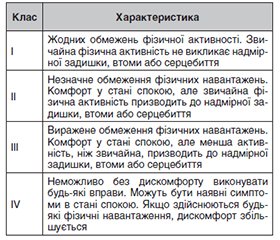Резюме
Стаття присвячена огляду класифікацій серцевої недостатності з акцентом на характеристики функціональних класів, поданих експертами Нью-Йоркської асоціації кардіологів (The New York Heart Association — NYHA). Наведені переваги класифікації NYHА для застосування в практиці сімейного лікаря як маркера стратифікації ризику, прогресування серцевої недостатності, госпіталізації хворих та призначення медикаментозного лікування. Підкреслена роль оцінки функціонального класу хворих для включення їх до рандомізованих контрольованих досліджень. Особливості перенесення хворими із серцевою недостатністю фізичного навантаження є еталонним критерієм у роботі медико-соціальних експертних комісій. На підставі аналізу публікацій наведена недостатня конкордантність помірних класів за NYHA з об’єктивними ідентифікаційними параметрами серцевої недостатності. Подано обґрунтування розширення діапазону обстеження хворих з підозрою на серцеву недостатність з подальшою можливістю встановлення фенотипу за фракцією викиду та наявністю cтадій А, B, C, D. Дієвим засобом запобігання структурним змінам міокарда та функціональній недостатності є ефективне лікування артеріальної гіпертензії.
The article deals with a review of heart failure classification with a focus on the characteristics of the functional classes proposed by the experts of The New York Heart Association (NYHA). The benefits of the NYHA classification for the use in practice of family doctors as markers of the risk stratification, progression of heart failure, patients’ hospitalization and prescribing drug treatment are shown. The role of assessing the functional classes of patients for including them in randomized controlled trials is emphasized. The peculiarities of exercise testing by individuals with heart failure are a reference criterion in the work of medical and social expert commissions. Based on the analysis of publications, an insufficient concordance of moderate NYHA classes with objective identification parameters of heart failure is presented. The rationale for expanding the range of examination of patients with suspected heart failure, with the further possibility of assessing the phenotype by ejection fraction and the presence of A, B, C, D stages is provided. An effective mean for preventing structural myocardial changes and dysfunction is treatment of hypertension.
Список литературы
1. Groenewegen A., Rutten F.H., Mosterd A. et al. Epidemio-logy of heart failure. Eur. J. Heart Fail. 2020. 22. 1342-1356.
2. 2023 Focused Update of the 2021 ESC Guidelines for the diagnosis and treatment of acute and chronic heart failure: Developed by the task force for the diagnosis and treatment of acute and chronic heart failure of the European Society of Cardiology (ESC) With the special contribution of the Heart Failure Association (HFA) of the ESC. McDonagh T.A., Metra M., Marianna Adamo M. et al. European Heart Journal. 2023 Oct 1. 44. Is. 37. 3627-3639.
3. 2022 American College of Cardiology/American Heart Association/Heart Failure Society of America Guideline for the Management of Heart Failure: Executive Summary. Heidenreich P.A., Bozkurt B., Aguilar D. et al., Writing Committee members. J. Am. Coll. Cardiol. 2022 May. 79 (17). e263-e421.
4. White P.D., Myers M.M. The classification of cardiac diagnosis. JAMA. 1921. 77(18). 1414-1415. doi: 10.1001/jama.1921.02630440034013.
5. Ahmed A. A propensity matched study of New York Heart Association class and natural history end points in heart fai-lure. Am. J. Cardiol. 2007. 99(4). 549-553. doi: 10.1016/j.amjcard.2006.08.065.
6. Maddox T.M., Januzzi J.L. Jr, Allen L.A. et al.; Writing Committee. 2021 Update to the 2017 ACC Expert Consensus Decision Pathway for Optimization of Heart Failure Treatment: answers to 10 pivotal issues about heart failure with reduced ejection fraction: a report of the American College of Cardiology Solution Set Oversight Committee. J. Am. Coll. Cardiol. 2021. 77(6). 772-810. doi: 10.1016/j.jacc.2020.11.022.
7. McDonagh T.A., Metra M., Adamo M., et al.; ESC Scientific Document Group. 2021 ESC guidelines for the diagnosis and treatment of acute and chronic heart failure. Eur. Heart J. 2021. 42(36). 3599-3726. doi: 10.1093/eurheartj/ehab368.
8. Yap J., Lim FY., Gao F. et al. Correlation of the New York Heart Association Classification and the 6-Minute Walk Distance: A Systematic Review. Clin. Cardiol. 2015. 38(10). 621-628.
9. de Borba Engster P.H., Zimerman A., Schaan T. Incremental Role of New York Heart Association Class and Cardiopulmonary Exercise Test Indices for Prognostication in Heart Failure: A Cohort Study. Arq. Bras. Cardiol. 2023 Nov. 120(11). e20230077. doi: 10.36660/abc.20230077.
10. Rohde L.E., Zimerman A., Vaduganathan M. Associations Between New York Heart Association Classification, Objective Measures, and Long-term Prognosis in Mild Heart Failure A Secondary Analysis of the PARADIGM-HF Trial. JAMA Cardiol. 2023 Feb. 8(2). 150-158. doi: 10.1001/jamacardio.2022.4427.
11. Blacher M., Zimerman A., Engster P.H.B., et al. Revisi-ting heart failure assessment based on objective measures in NYHA functional classes I and II. Heart. 2021. 107(18). 1487-1492. doi: 10.1136/heartjnl-2020-317984.
12. Greene S.J., Butler J., Spertus J.A., et al. Comparison of New York Heart Association class and patient-reported outcomes for heart failure with reduced ejection fraction. JAMA Cardiol. 2021. 6(5). 522-531. doi: 10.1001/jamacardio.2021.0372.
13. Caraballo C., Desai N.R., Mulder H., et al. Clinical implications of the New York Heart Association classification. J. Am. Heart Assoc. 2019. 8(23). e014240. doi: 10.1161/JAHA.119.014240.
14. Raphael C., Briscoe C., Davies J., et al. Limitations of the New York Heart Association functional classification system and self-reported walking distances in chronic heart failure. Heart. 2007. 93(4). 476-482.
15. Patel R.B., Vaduganathan M., Greene S.J. et al. Nomenclature in heart failure: a call for objective, reproducible, and biologically-driven terminology. Eur. J. Heart Fail. 2018. 20(10). 1379-1381. doi: 10.1002/ejhf.1231.

